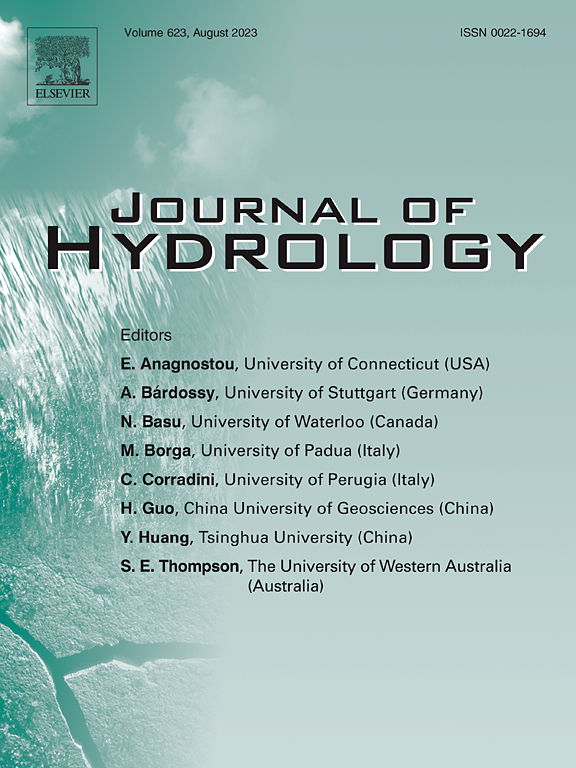CEASA: Dominant spatial autocorrelation in dual-constraint calibration as the game-changer for hydrological modeling with high-uncertainty remotely sensed evaporation: Application to the Meichuan basin
IF 6.3
1区 地球科学
Q1 ENGINEERING, CIVIL
引用次数: 0
Abstract
Accurate evapotranspiration (ET) estimation is vital for hydrological modeling, yet remotely sensed ET (RS-ET) products are often limited by algorithmic uncertainties and sensor biases. To mitigate error propagation and better capture spatial patterns, this study introduces the Composite Efficiency of Absolute ET and Spatial Autocorrelation (CEASA) —a dual-constraint framework that integrates absolute ET magnitude and spatial autocorrelation to enhance simulation accuracy, which marks a pivotal shift by moving beyond traditional individual-value-based calibration to incorporate spatially explicit pattern constraints.
Using four RS-ET products in China’s Meichuan Basin (three high-bias: MOD16, GLASS, SSEBop; one low-bias: PMLV2), CEASA demonstrated: (1) Dual-constraint superiority: CEASA outperformed single-constraint methods. Compared to the absolute-value-only scheme (M1), it reduced PBIAS by 18–33 % and improved KGE from 0.47 to 0.51 to 0.76–0.77 under high-bias datasets, meanwhile improving KGE to 0.84 and reducing PBIAS to 9.4 % under low-bias PMLV2. It also surpassed spatial-pattern-only approaches by 11 % in KGE under low-bias data. Notably, CEASA achieved comparable streamflow accuracy to streamflow-based calibration (M0) while improving ET simulation. (2) Quality adaptivity: CEASA’s weighted dual-criteria architecture dynamically adapted to RS-ET quality—achieving peak performance for PMLV2 and maintaining stable accuracy for high-bias datasets by emphasizing spatial neighborhood information. (3) Spatial dominance: Entropy analysis showed spatial autocorrelation contributed >70 % of the optimization signal, with higher information content than absolute ET magnitude (2.85–3.42 vs. 0.39–1.22).
CEASA redefines RS-ET application by emphasizing spatial patterns, offering a bias-resilient solution for ungauged basins. Future work should explore scale-sensitive metrics and intelligent weighting schemes for broader applicability.
基于高不确定性遥感蒸发的双约束定标优势空间自相关:在梅川流域的应用
准确的蒸散发(ET)估算对于水文建模至关重要,但遥感ET (RS-ET)产品往往受到算法不确定性和传感器偏差的限制。为了减少误差传播和更好地捕获空间模式,本研究引入了绝对ET和空间自相关的复合效率(CEASA)——一个集成绝对ET大小和空间自相关的双约束框架,以提高模拟精度,这标志着从传统的基于个体值的校准到结合空间显式模式约束的关键转变。4种RS-ET产品在中国梅川盆地的应用(3种高偏置:MOD16、GLASS、SSEBop;(1)双约束优势:该方法优于单约束方法。与纯绝对值方案(M1)相比,该方案在高偏置数据集下将PBIAS降低18 - 33%,将KGE从0.47 - 0.51提高到0.76-0.77,同时在低偏置数据集下将KGE提高到0.84,将PBIAS降低到9.4%。在低偏差数据的KGE中,它也比仅使用空间模式的方法高出11%。值得注意的是,CEASA在改善ET模拟的同时,实现了与基于流量的校准(M0)相当的流量精度。(2)质量自适应:CEASA的加权双标准架构动态适应RS-ET质量,在PMLV2中实现峰值性能,并通过强调空间邻域信息保持高偏差数据集的稳定精度。(3)空间优势:熵分析显示空间自相关贡献了70%的优化信号,信息量高于绝对ET量(2.85 ~ 3.42比0.39 ~ 1.22)。通过强调空间模式,CEASA重新定义了RS-ET的应用,为未测量的盆地提供了抗偏性解决方案。未来的工作应该探索尺度敏感指标和智能加权方案,以获得更广泛的适用性。
本文章由计算机程序翻译,如有差异,请以英文原文为准。
求助全文
约1分钟内获得全文
求助全文
来源期刊

Journal of Hydrology
地学-地球科学综合
CiteScore
11.00
自引率
12.50%
发文量
1309
审稿时长
7.5 months
期刊介绍:
The Journal of Hydrology publishes original research papers and comprehensive reviews in all the subfields of the hydrological sciences including water based management and policy issues that impact on economics and society. These comprise, but are not limited to the physical, chemical, biogeochemical, stochastic and systems aspects of surface and groundwater hydrology, hydrometeorology and hydrogeology. Relevant topics incorporating the insights and methodologies of disciplines such as climatology, water resource systems, hydraulics, agrohydrology, geomorphology, soil science, instrumentation and remote sensing, civil and environmental engineering are included. Social science perspectives on hydrological problems such as resource and ecological economics, environmental sociology, psychology and behavioural science, management and policy analysis are also invited. Multi-and interdisciplinary analyses of hydrological problems are within scope. The science published in the Journal of Hydrology is relevant to catchment scales rather than exclusively to a local scale or site.
 求助内容:
求助内容: 应助结果提醒方式:
应助结果提醒方式:


